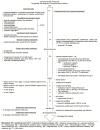Anesthetic management for cesarean section in two parturient with ascending aortic aneurysm: a case-based discussion
- PMID: 38711027
- PMCID: PMC11071247
- DOI: 10.1186/s12871-024-02553-2
Anesthetic management for cesarean section in two parturient with ascending aortic aneurysm: a case-based discussion
Abstract
Background: The anesthetic management of parturients with ascending aortic aneurysm for cesarean section can be particularly challenging, primarily because of increased risk for aortic dissection or aneurysm rupture.
Case presentation: We present some aspects of the anesthetic management of two parturients with ascending aortic aneurysm for cesarean sections; amongst, the use of remifentanil with its effects on patient and newborn. We emphasize the importance of a cardio-obstetric team in the context of preoperative planning of such patients. Also, we reviewed some literature on the anesthetic management with its effect on peri-operative hemodynamic stability.
Conclusion: Maintaining hemodynamic stability is paramount in the prevention of the rupture or dissection of ascending aortic aneurysm during labor of parturient.
Keywords: Anesthesia; Aortic dissecting aneurysm; Ascending aortic aneurysm; Cesarean section; Remifentanil; Ruptured aneurysm.
© 2024. The Author(s).
Conflict of interest statement
The authors declare no competing interests.
Figures




Similar articles
-
General anesthesia using remifentanil for Cesarean delivery in a parturient with Marfan's syndrome.Can J Anaesth. 2008 Aug;55(8):526-31. doi: 10.1007/BF03016673. Can J Anaesth. 2008. PMID: 18676388
-
The use of remifentanil in general anesthesia for cesarean section in a parturient with severe mitral stenosis and pulmonary edema.Middle East J Anaesthesiol. 2010 Feb;20(4):585-8. Middle East J Anaesthesiol. 2010. PMID: 20394260
-
The use of remifentanil for Cesarean section in a parturient with recurrent aortic coarctation.Can J Anaesth. 2000 May;47(5):454-9. doi: 10.1007/BF03018976. Can J Anaesth. 2000. PMID: 10831203
-
Anesthetic Management of Cesarean Sections in Parturients with Valvular Heart Disease.Ann Afr Med. 2025 Apr 1;24(2):483-485. doi: 10.4103/aam.aam_124_24. Epub 2025 Mar 4. Ann Afr Med. 2025. PMID: 40038558 Free PMC article. Review.
-
Anesthetic management of cesarean delivery in parturients with ruptured sinus of Valsalva aneurysm: CARE-compliant 2 case reports and literature review.Medicine (Baltimore). 2017 May;96(19):e6833. doi: 10.1097/MD.0000000000006833. Medicine (Baltimore). 2017. PMID: 28489765 Free PMC article. Review.
Cited by
-
Popliteal sciatic nerve block versus intrathecal anesthesia for Achilles tendon rupture repair surgery: a mono-centric retrospective comparative study.Front Med (Lausanne). 2025 Jul 21;12:1516874. doi: 10.3389/fmed.2025.1516874. eCollection 2025. Front Med (Lausanne). 2025. PMID: 40761867 Free PMC article.
-
Anesthetic Management for Delivery in Parturients with Heart Disease: A Narrative Review.Biomedicines. 2025 Jul 16;13(7):1736. doi: 10.3390/biomedicines13071736. Biomedicines. 2025. PMID: 40722806 Free PMC article. Review.
-
Endovascular Treatment of a Symptomatic Vertebral Artery Aneurysm in a Puerperal Patient with Neurofibromatosis Type 1-A Case Report and Review of the Literature.Diseases. 2025 Jul 18;13(7):226. doi: 10.3390/diseases13070226. Diseases. 2025. PMID: 40710016 Free PMC article.
References
Publication types
MeSH terms
Substances
LinkOut - more resources
Full Text Sources
Medical

